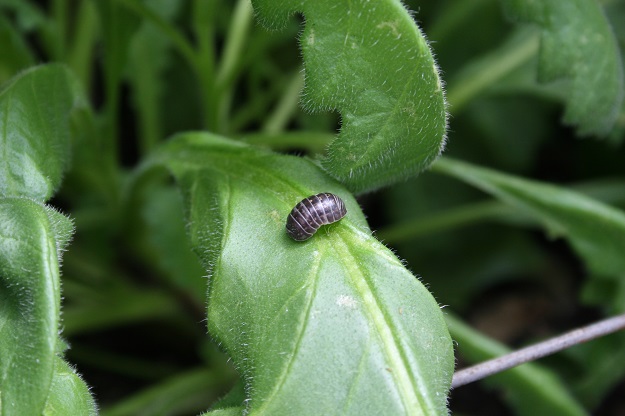Sowbugs and pillbugs are not insects but are classified as isopods or crustaceans, closely related to crayfish and crabs, and are distributed worldwide. The most common sowbug and pillbug species are Porcellio laevis and Armadillium vulgare. In Europe, sowbugs and pillbugs are commonly called woodlice. Both are oblong, oval or convex in shape, segmented, and are flattened underneath the body. They are black, gray, or brown in color, and approximately 19 mm (3/4 inches) in length when full-grown. The broad head contains a pair of eyes, two pairs of antennae, and chewing mouthparts. They also have seven pairs of legs. Sowbugs have two small, tail-like appendages (uropods) located at the end of the body; pillbugs do not have appendages. Sowbugs and pillbugs are distinctly segmented with seven hardened individual overlapping plates. Pillbugs can roll-up into a ball when disturbed (thus the common name ‘roly-poly’) whereas sowbugs cannot.

Sowbugs and pillbugs have a particular biology in which eggs and young remain inside females for several months inside a pouch-like marsupium. This provides protection from predators and prevents desiccation (drying up). Females may produce two or more broods during the year with between 20 and 28 young per brood. Both sowbugs and pillbugs primarily feed on decaying organic matter and fungi because they possess weak chewing mouthparts; however, they may occasionally feed on the stem and/or roots of young seedlings, and will feed on young, tender vegetation or fruit. They can cause damage to beans, lettuce, and other vegetable crops.
Sowbugs and pillbugs are nocturnal (night-time) feeders hiding during the day under rocks, plant debris, boards lying on the ground, and in mulch; however, they may be observed during the daytime after rains or when conditions are overcast. They may also burrow several inches into soil. Both sowbugs and pillbugs require constant moisture for survival since they cannot control or regulate water loss from their bodies as they lack a waterproof exoskeleton. Adults may live up to 2 years or more. Sowbugs and pillbugs may occasionally enter homes, primarily damp areas such as basements and around house plants. They may enter greenhouses during the winter due to suitable environmental conditions (e.g., temperature and moisture).
Management
The primary means of dealing with sowbugs and pillbugs is by habitat manipulation. For example, raking mulch and leaf debris will expose sowbugs and pillbugs to natural enemies and pest control materials. Applications of pest control materials are generally not required indoors because sowbugs and pillbugs will quickly dry-out and die after entering homes. Commercially available products for homeowners labeled for control or suppression of sowbug/pillbug populations (primarily outdoors) may contain the following active ingredients; beta-cyfluthrin, lambda-cyhalothrin, permethrin, and gamma-cyhalothrin. Another product commercially available contains a combination of materials including 2-phenethyl propionate, sodium lauryl sulfate, eugenol, thyme oil, and sesame oil. Most of these active ingredients will only kill sowbugs and/or pillbugs on contact so repeat applications may be required.
Dr. Raymond A. Cloyd is a Professor and Extension Specialist in Ornamental Entomology/Integrated Pest Management in the Department of Entomology at Kansas State University. He can be contacted at:
Dr. Raymond A. Cloyd
Kansas State University
123 Waters Hall
Manhattan, KS 66506
P – 785.532.4750
Email: rcloyd@ksu.edu
Related Articles & Free Email Newsletter
How to Identify & Control the Tomato Russet Mite
What’s This Bug? The Cicada Killer Wasp



Comment here